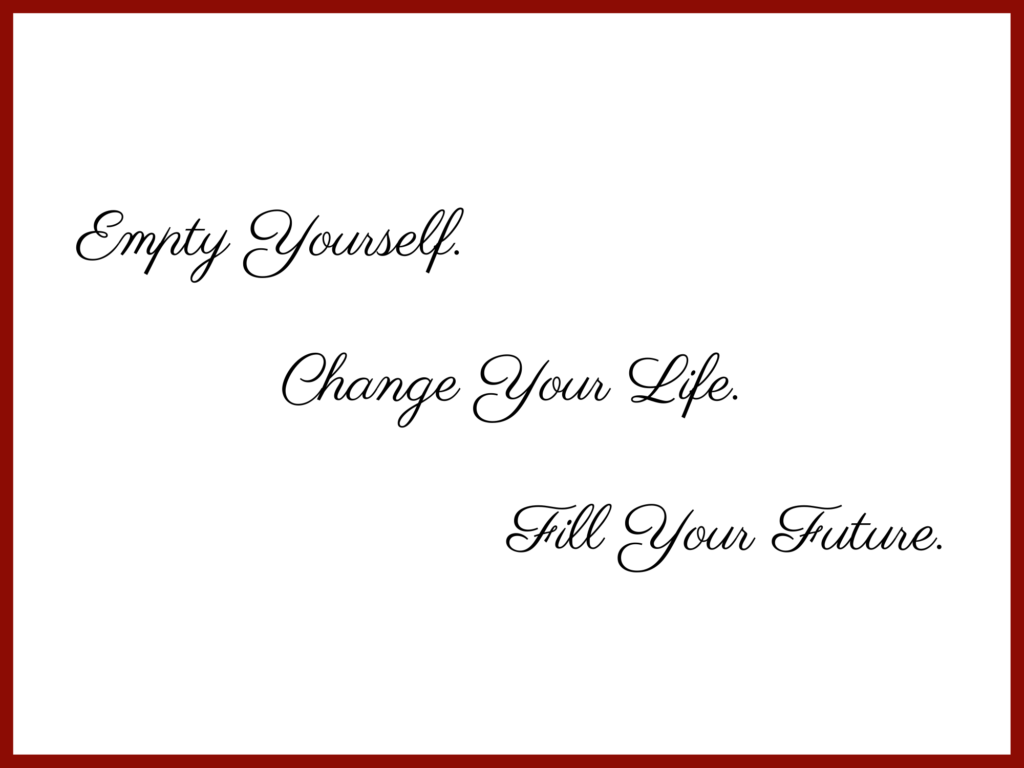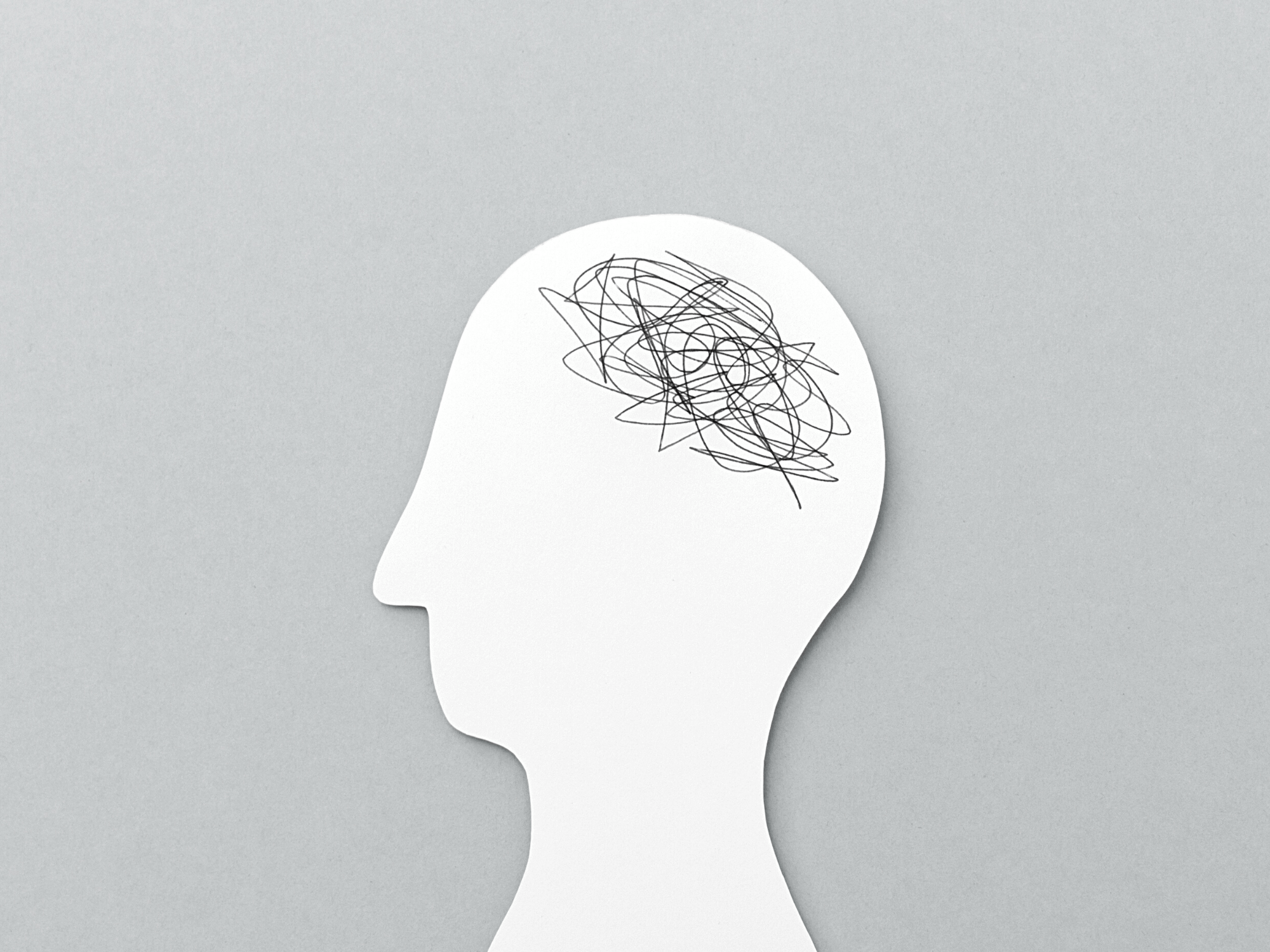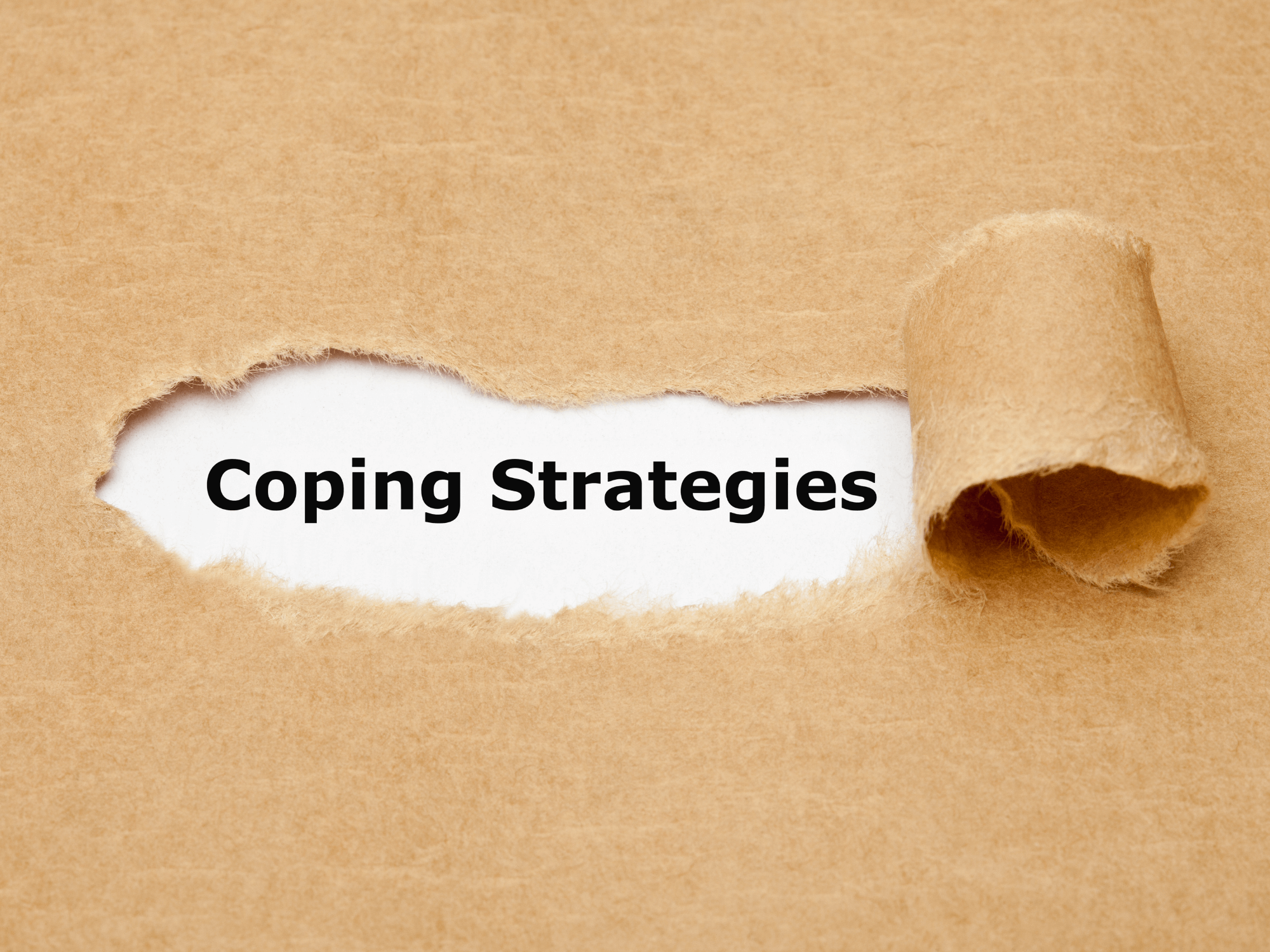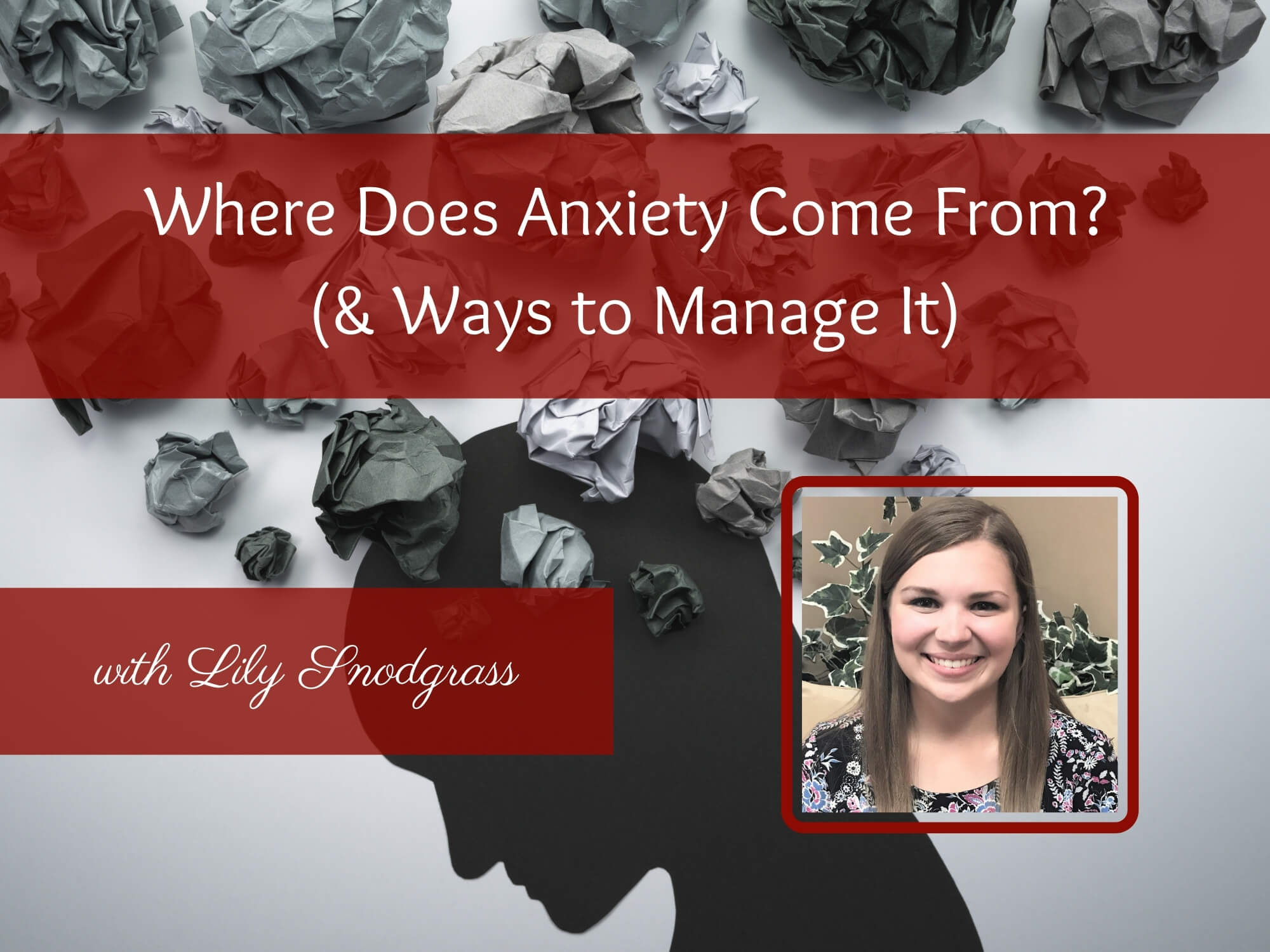Here at Kenosis, our mantra is Empty Yourself. Change Your Life. Fill Your Future. Since the early 2000s, we’ve believed in the positive impact these 3 seemingly simple steps can have on your life.
Because anxiety and depression are topics that frequently come up for our clients, we wanted to take a deeper look at how the Empty Yourself. Change Your Life. Fill Your Future mantra can help people who are facing these mental health challenges.
We talked to Kenosis therapist Lily Snodgrass about what the mantra means to her, what therapy looks like for people with anxiety, and how emptying yourself can significantly improve your anxiety.

What Does the Kenosis Mantra Mean to You?
Lily has been with Kenosis since January 2021. She began as an intern, and was hired as a therapist in August. With a Master’s degree in Social Work from Indiana University, she’s trained in EMDR (Eye Movement Desensitization and Reprocessing), Cognitive Behavioral Therapy (CBT), and Dialectical Behavior Therapy.
She uses attachment based practices with her clients, and enjoys working with all ages from children to adults. Because of her training in EMDR, which is usually used to treat trauma, she works with many clients who have PTSD, anxiety, and depression.
When you speak with Lily, it’s obvious she’s passionate about helping people, and loves what she does. For her, the mantra is an important part of treatment for mental health conditions.
In her eyes, emptying yourself is “really the first step in getting help. It’s the first step of being willing to go in to talk to somebody to tell your story.” When you’ve shared your story with someone, you can begin the process of changing your life. This is the part, Lily says, where treatment comes into play, as well as “a therapeutic relationship and rapport.”
When you’re receiving treatment and building a strong therapeutic relationship, you can then begin to think about what you want from the future. “Fill your Future, with anxiety and depression specifically, makes me think about the different tools and learning, and really the results of participating in therapy,” she explains.
For anxiety and depression, the first step of getting help and beginning to empty yourself is critical.

Where Does Anxiety Come From?
As a therapist, Lily works with all kinds of people.
She’s noticed a pattern though: many women, both young and mature, have anxiety due to a “lack of self-esteem and self-confidence.” This lack of confidence and self-esteem can present itself as anxiety in a number of situations because the women “don’t necessarily believe in their capabilities.”
Although this looks different for everyone, some common anxieties Lily notices are social anxiety, generalized anxiety, and anxiety about parenthood.
Interestingly, men seem to present different types of anxiety. Although she’s counseled more women, the men tend to feel anxiety “from a sense of responsibility.” Rather than a lack of confidence or self-esteem, the men Lily’s worked with seem to be more worried about “providing or being a dad or being a husband and partner.”
It’s clear that anxiety can come from any number of places, for many reasons. No matter how anxiety presents itself, or what society as a whole believes, unfortunately, you can’t just “get rid of” it. In fact, coming into therapy thinking you can get rid of mental illness “isn’t realistic at all,” she notes.
If you can’t get rid of it, what can you do about it?
No one wants to be anxious, and for many people, the point at which they reach out to get help is a breaking point – a point where they can’t manage the anxiety and/or depression on its own and are therefore enlisting help.
After all, you can’t just ignore anxiety and hope it goes away. Lily emphasizes, “If you don’t acknowledge the anxiety as what it is, it will present in your body and show you.”
What therapy offers is help coping with anxiety. “With anxiety, we want to decrease severity and decrease frequency,” she says. Although it “may not ever be zero” the goal is to “give you the tools to fight it when it does come up.”
For some, mental health treatment may be a new concept. It can be helpful to think of it in terms of something more familiar: “Much like you have an inhaler to deal with asthma attacks, you have coping skills and are grounded in mindfulness to deal with anxiety so we can put it away at that present moment.”

What are Some Coping Methods You Recommend for Anxiety?
If you have an idea of where anxiety is coming from, or have been able to identify that you have anxiety, you can get help. “The first step, and the hardest, is reaching out,” Lily points out.
During their first appointment, often called an intake appointment, she says a lot of people “really just unload.” From there, you can begin to learn skills to help manage your anxiety.
Therapy for anxiety “starts with stabilization,” which means the therapist will teach you “coping skills, grounding skills, and mindfulness.” While it may seem simple, knowing how to stabilize yourself is important for anxious people “because anxiety is anticipation, so we want to be able to ground clients in the present moment.”
When you learn the skills, and practice using them, they can have an impact all the way down to your nervous system. In fact, “they’re an intervention for relaxing and soothing the nervous system.”
Some of Lily’s favorite anxiety coping methods are:
- The Safe or Calm Place Visualization – an exercise where you visualize a calm and comfortable place to relax your mind
- Deep Breathing Exercises – to become aware of your body and steady your breathing to relax
- Container Activity – an exercise to “contain your anxious thoughts and put them away”
- Mindfulness – a practice to become aware and in-touch with your body and mind so that you can regain control of your anxiety
- Progressive Muscle Relaxation – an exercise that can help you release tension in your body to become more relaxed
- 54321 Grounding Activity – a practice that can ground you when you’re feeling very anxious. You think of “5 things you can see, 4 you can feel, 3 you can hear, 2 you can smell, and 1 you can taste.”
Although these are often go-tos for Lily, there are “more client specific activities based on the severity” of someone’s anxiety.
Many of these coping activities can also work for people who have anxiety and depression, which are “two biggest concerns that people come in with.” Lily explains that anxiety is “definitely comorbid with depression” which means they can occur at the same time, often because the symptoms overlap.
In fact, many people come to therapy thinking they have “more depressive tendencies when really it presents as anxiety.” Usually only one is the “presenting issue.” For instance, if anxiety is really high, the person could still have depression, but the depressive symptoms may be lower. On the other hand, if depression is higher, they might have some anxiety but less than they would if the anxiety was more present.
Lily estimates that “probably well over half” have both anxiety and depression.
Since she specializes in EMDR, she also sees many clients with PTSD, which often comes with high anxiety.

How Do You Think “Emptying Yourself” Can Help with Anxiety?
Although taking the first step to empty yourself is the hardest, it definitely pays off. With anxiety, emptying yourself is “letting go of those future-oriented or potentially past-oriented thoughts,” Lily explains.
“Letting go of those thoughts and allowing yourself to stay present” is key, although it can be challenging at first. Many people have anxious thoughts and before they realize it they’re “already down a rabbit hole.” Being able to “empty that out, contain it, or put it away,” to stay in the present helps control anxiety before it begins to feel out of control.
It can be challenging to work on these skills because, as Lily explains, “People don’t necessarily have faith that the skills work. They’re not something that happens overnight. It takes practice, and effort, but the skills do work,” she says. You have to be able to “trust the process” for it to really work, and emptying yourself is part of that process.
Lily frequently sees the process working successfully. In fact, she recalls a specific client who first came to her when she started at Kenosis who was on “really high doses of medication” and anxiety was “impacting her functioning.“
At the beginning, they did some EMDR work. The first step of EMDR is grounding. Throughout the therapy process, Lily emphasizes that the client has “shown tremendous progress.” She’s off of medication, and “her thinking patterns are much more stable and present.”
The client uses a lot of safe place and container methods, as well as deep breathing to control her anxiety. Now, Lily says, “She’s able to really catch herself when she’s starting to go into that future/past thinking.”
A testament to how much these methods can change your life, if you’re willing to take the first step and empty yourself.

